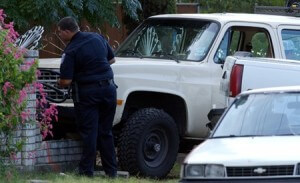I had always wanted to write a story about police chases after I watched a crazy high-speed pursuit unfold on local TV. I wondered how often these chases go bad, and how the San Antonio Police Department keeps track of that information.
 Law enforcement agencies usually churn out paperwork for every situation known to man. I made some phone calls and learned that officers must fill out a pursuit-evaluation form after they chase someone. The reports have check boxes for different categories of information, such as whether someone was injured during the chase. When you see boxes like that on a report, chances are, some hapless soul at the government agency types that information into a database. It turned out SAPD has been compiling a database that tracks details of every chase by all its officers.
Law enforcement agencies usually churn out paperwork for every situation known to man. I made some phone calls and learned that officers must fill out a pursuit-evaluation form after they chase someone. The reports have check boxes for different categories of information, such as whether someone was injured during the chase. When you see boxes like that on a report, chances are, some hapless soul at the government agency types that information into a database. It turned out SAPD has been compiling a database that tracks details of every chase by all its officers.
If you work for a news organization or a blog and stumble upon a previously unknown database filled with rich details about an important public policy issue, you’ve found a great story. Request a copy of the raw data and analyze it. You might be able to tell your audience something new about the world.
Related: Telling stories with data: Police chases and drug smugglers on the Texas-Mexico border
SAPD’s pursuit database formed the foundation for my story that ran Sunday. The numbers show that two out of five pursuits damaged cars or property. The number of chases and crashes peaked in 2008, but dropped in 2009 after SAPD emphasized vehicle safety to its officers:
Here’s a copy of the raw data for the years 2003-2009. To me the numbers highlight the difficult position officers are in during a police chase, but they managed to make progress last year.
Getting the data was important. But it didn’t tell the full story — it was missing narratives describing what happened during the chase. The narratives were written down in the hardcopy pursuit reports. So I requested copies of reports for a bunch of chases, including a pursuit that led to the most recent death of an innocent bystander in San Antonio, 85-year-old Edna Hurst:
Pursuit-evaluation report describing a police chase by the San Antonio Police Department by John Tedesco
I also asked for a copy of SAPD’s pursuit policy. It describes the situations in which officers are permitted to pursue suspects. The policy also mentioned that Blue Eagle, the police helicopter unit, is supposed to videotape pursuits if the helicopter is able to assist. So I asked for some videos and came across this incident involving a reckless driver of a pickup truck, which I thought was a good example showing the dynamics of how officers handle chases.
The chase database doesn’t show the location of where the pursuit begins. But it does have a case number for each chase. Using that number, Mike Howell of mySA.com linked the data to Crimebase, a gargantuan data file of offense reports we receive from SAPD. Mike made an interesting map showing where chases occurred in the city in 2009. Click on a chase, and it calls up details from the pursuit data, and a link to a Crimebase report with a brief narrative.
The point of all this work isn’t to make SAPD look bad. It’s to offer people relevant information about a life-or-death issue. I learned a lot working on this story. If we did our job right, so did our readers.



